Even if you think that it’s easier to throw your rusted tools away and simply getting new ones, you should know that it’s often possible to remove the rust from the metal using these natural, DIY ways to do it. We’ll also cover commercial products in this article that can help you. A lot of the products you’ll be needing, you can actually find in your kitchen, and if you put some commitment into it, you can revive a lot of the rusted metal you thought you’d just throw out.
What is Rust?
Rust, often referred to as iron corrosion or iron oxide, happens when the outer layer, or the coating, starts oxidizing. Rust comes in different shades of orange, red and brown. Rust can also be dangerous, if it weakens the underlying metal so much that it is no longer suitable for what it was built for, and structures could collapse after too much rusting. If you have wrought iron railings installed at home, you should make sure to inspect them from time to time.
Think about an old rusty car like this one, and it’s not difficult to imagine that it would have trouble serving as a functioning car with all the likely rust in the motor.
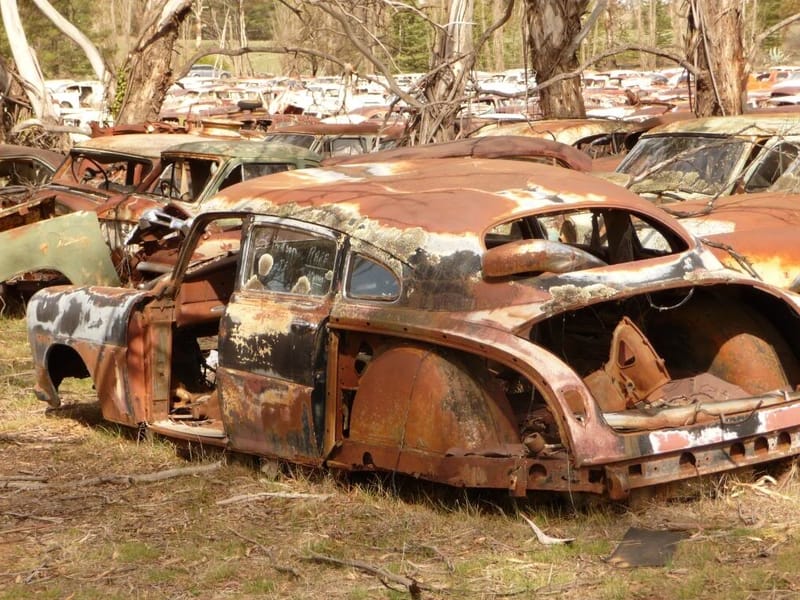
If pipes end up rusting, you can also imagine that eventually they give up due to the water pressure and end up bursting, which can cause serious water damage. With pipes in the US being more than 100 years old in a lot of places, it’s not uncommon to see rusted pipes, that can lead to the water becoming red as a consequence. It’s good to know that rusty water is in fact not a health concern, even if it may end up having a bad taste.
There are a lot of things you can do to help keep metal from rusting by adding coatings and paints by stopping unnecessary oxygen from being able to reach the iron.
Ways to Prevent It In the First Place
There are certain conditions that will speed up the rusting process, which includes if iron or metal is stored outside. In humid climates, or when it’s rainy outside, things are more likely to rust, and faster. There are, however, things you can do to stop this from happening or minimizing the effects.
When you create the metal structure, there are certain design considerations that will help keep rust away. You will want to do whatever you can to limit the amount of cavities and crevices where metals meet, and joints should be welded together to minimize the exposure to oxygen among the different metal elements, to limit oxygen flow between. Although you may be able to add a protective layer outside metal, it’s hard to do it in those joints.
Metal can also be galvanized to stop it from rusting, where you hot-dip iron or steel in molten zinc which creates a corrosion resistant coating. Instead of having the steel or iron oxidize, it will be the outer zinc layer that does, protecting the overall structure.
You can also do what is called bluing of the steel, which will keep it from rusting.
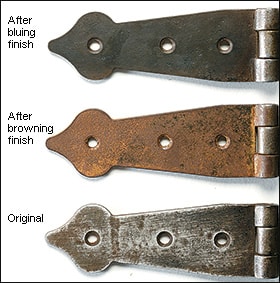
Picture from Lee Valley
The process of bluing is explained in the video below.
Learn more about bluing right here
This process can be used for fine clocks and other fine metal work.
If someone talks about organic coating, what they’re talking about is using a primer like this one, before the metal is then later on painted. These coatings act as barriers by forming an outer layer on top of the surface that needs protection. To ensure it works as well as possible, use an oil-based primer, and the thickness should be 25 micrometers to offer good protection against the elements.
Whatever material you choose to apply, make sure that you know the difference between rust-resistant and rust-proof. Rust-resistant will mean that it does a better job at protecting, although with time, it may get damaged due to severe elements. If a rock hits your car that previously had a rust-resistant material on it, it will likely break the seal, at which point the metal is now left exposed.
If you notice any of your tools starting to have rust on them, you should use basic maintenance to work on getting it off, which involves scraping it off with a razor blade, for example. If there’s dirt on metal, it should also be cleaned off to avoid deterioration.
Best Inhibitors
Rather than trying to have to remove rust later on, the easiest thing for you to do is to avoid it appearing in the first place. Look at the different rust inhibitors on Amazon, or visit a site like Consumer Charts, where you can see a comparison between the different options available on the market.
As well as inhibiting rust, it’s also important that you remove it. Rust inhibitors are often confused with solutions that will remove it. For rust removal solutions, Popular Mechanics has this guide.
You should know that one doesn’t necessarily do the job of the other, so first you’ll need to remove any and all rust before you prevent more from developing. You will also need to apply the inhibitor more than once. It’s not something you just apply once and then it stays on for life. Make sure to read the recommendations of the product you choose to go with.
The solution you choose to go with should work as well as possible for the functions you need the given piece of metal for, and it can’t just be an inhibitor that is washed off after a little bit of rain, or you will need to reapply it quickly again.
Some of the successful inhibitors we were able to find included “The Rust Stopper” from HinderRUST, with very positive reviews on Amazon.
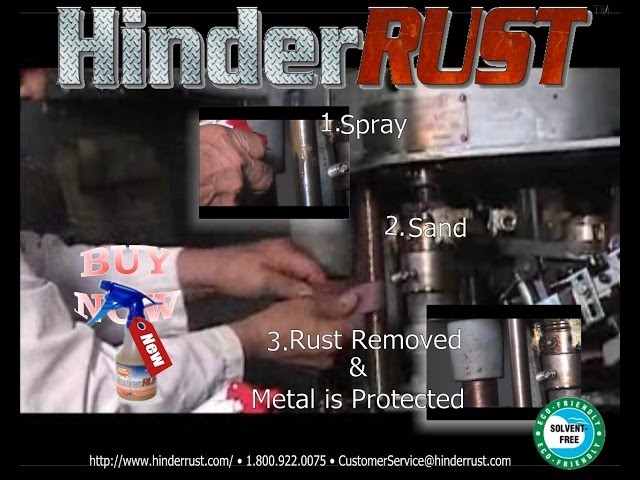
Picture from Fluoramics
If you need an aerosol, because you’re trying to get into little places that are hard to get to, consider the TC-11. It not only works as a rust remover but also as an inhibitor.
Ways to Remove Rust
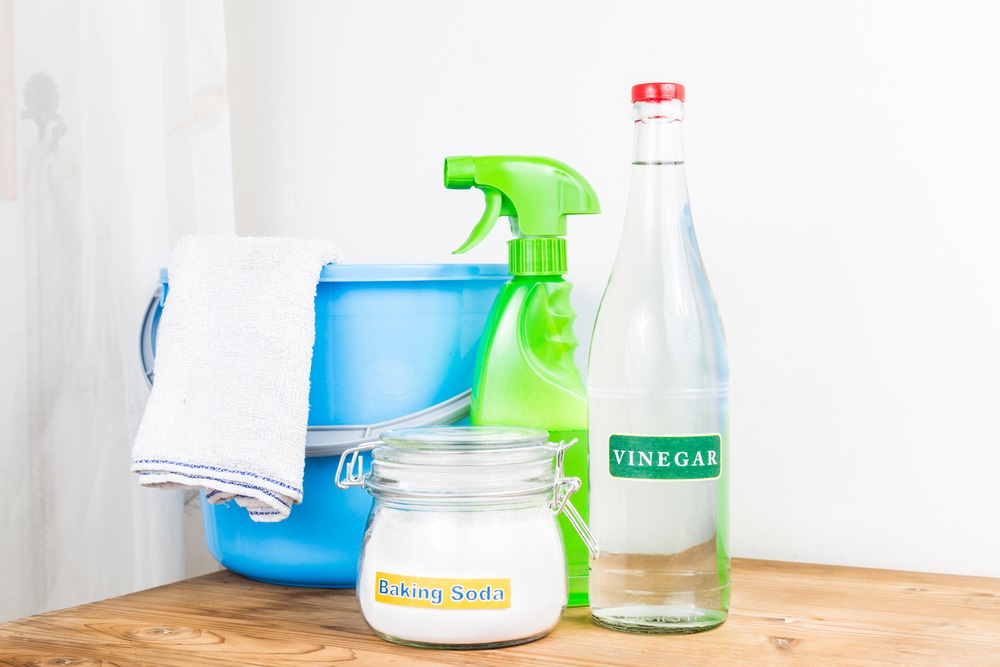
There are many commercial products available on the market, but there are also natural products you can use to remove rust, many of these which you probably already have available in your home. Removing rust is surprisingly easy with smaller tools. In fact, with a lot of these solutions you don’t even have to do a lot, but just let the material do its magic.
One of the easiest ways to remove rust is by using white vinegar. What happens is that the acid dissolves the rust particles, and they fall off. All you need to do is put the rusted metal in a bath of white vinegar from a couple of hours to a day. Afterwards, you can easily scrub off all the remaining articles. This is what the process looks like.
You can even see what 19 months of vinegar did to Andrew Reuter’s tools right here.
Since it’s the acid that reacts with the rust, you can also use lime and salt for the purpose of getting rid of rust. What you will need to do is put a bit of salt evenly spread across the surface with the rust on it, and then the juice from the lime goes on top of the salt. Make sure that you have enough juice for the purpose. Leave it on there for three hours, and the rust should come off easily afterwards just by gently scrubbing it. Lemon juice works equally well given that it has a high acid content too.
Don’t have any of those ingredients at home, then try using baking soda instead. You will want to make a baking soda paste by mixing it with a bit of water. Once that’s been done, add it to the rusted surface and leave it for an hour, and the object is ready to be scrubbed clean. Rinse it with water afterwards to get all of it off.
You can also use oxalic acid. However, given its pH value of 1.3, this stuff is a very strong acid, you should make sure that it doesn’t get into contact with your skin or anything else it would react strongly with. Get some good rubber gloves that will protect your hands, and consider wearing safety goggles too. Look at the instructions on the bottle of oxalic acid on how to handle it safely, and make sure you know what to do if something goes bad. You should also avoid inhaling the fumes created, which is why most people will use a gentler solution.
When you soak the object, do it in a mixture of 25ml oxalic acid with 250ml of water, which will give the concentration a slightly higher pH value, thereby bringing it closer to neutral. A soak of 30 minutes should be enough to remove the rust. Afterwards, again scrub th e surface and rinse it to remove any remaining acidic solution.
If you get a commercial solution, it’s the same underlying principle that removes the rust. The acid reacts with the oxidized metal, and it is then removed. If you get a commercial solution, make sure to only use it according to the specifications indicated on the bottle.
If you’re up for the work, you can uses abrasive tools such as sandpaper to remove it. Steel wool is also an option. When you do it like this, you will want to go for the biggest patches of rust first, and get those removed, which is where you can use more force. When the rust starts disappearing, be gentler and go for the smaller rust particles.
If you haven’t done this before, go to your local grocery store and get some vinegar to try it out – it’s very easy!
Chrome
While it is in fact not the chrome itself that rusts, but the material underneath it, we’ll here walk you through how to remove rust from surfaces that have received a chrome coating, which is what gives it its silver look. The same way that you can use a lot of household products, it is no different when rust starts appearing on chrome treated surfaces.
In fact, aluminum foil is great for the purpose. What you will need is to take it and scrub it against the places where you see the rust appearing. After scrubbing it against the chrome, you can see the little rust particles being removed from the surface, which can then easily be wiped off with a piece of cloth.
The advantage of using aluminum to remove the rust is that it’s a softer material than the metal the rust is on, and it should therefore leave very few scratches as a consequence.
Ideally, chrome is being used to provide for a shiny and protective coating to metal objects. Usually, it is the metal that’s below the chrome that is often the source of rust. Just like metals, it is also possible to use household products in removing rusts from chrome. Here are the steps on how to go about this.
If you dip the aluminum in salt water before scrubbing it, it will become an even better rust remover. Rust residue will accumulate, and you’ll need to stop to wash it off before continuing, if the surface is very rusty.
Make sure that the surface is dry, and then apply polish or wax on it afterwards, which will slow down the process of rusting by forming a protective layer. Instead of aluminum foil, you can also use steel wool.
Removing it From Cars
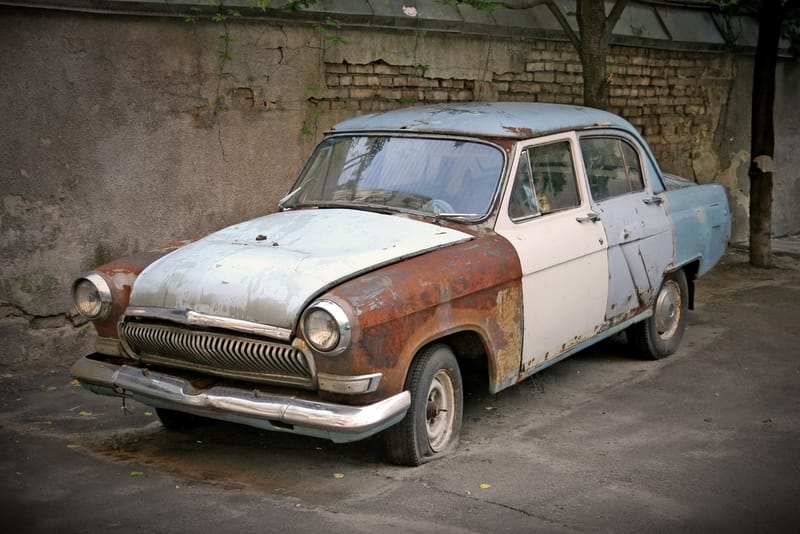
If you notice rust on your car, it’s actually very important that it be removed as soon as possible. If not, it could just make matters worse, especially you’re headed towards worse weather that includes a lot of snow, as salt will soon be hitting the roads to thaw the ice and snow. While this may be good at making the roads safer to drive on, it does nothing good to your car, and can simply make the affected area bigger, and increasing the area that has access to oxygen.
Air, salt and moisture are horrible components that will leave your car rusting quicker than you thought it was possible.
Rust on your car is an indication that the protecting seal is no longer doing its job, and the best solution is to repaint the car, or at least the place where you start seeing rust. First, though, you will need to remove the rust.
First, make sure to get the surrounding paint and problem area sanded down using a sander. When that’s been done, both paint and the previous primer that was applied is now gone, and the rust is no longer to be seen. The surface should be very smooth and ready for more work at this point.
Afterwards, apply a primer to the area that’s been treated, that will ensure the paint better sticks. Use primer according to the specifications of the manufacturer. If need be, use sandpaper to make the surface smooth after adding the primer, and then spray the paint on it. You will need to look out for the best materials to make it as little obvious as possible.
If you suspect the existing paint contains lead, it’s important to leave the job to professionals, as inhaling lead particles will be very unhealthy.
How to Remove Stains on Concrete
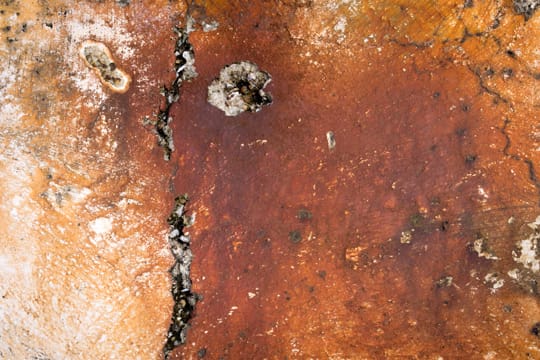
You could start seeing rust on top of your concrete surfaces, and you should know that it’s not the end of the world, and that it can be removed. This can come from the iron in well-water, for example, and if it isn’t removed, it will get more and more significant, and a lot of people do not like the way they look.
Here’s what you can do. First of all, you need to make sure the surface is clean by washing it, which will get rid of all the dirt and debris on there, which could otherwise mean that your treatment won’t be as effective. After cleaning the floor, you should ensure that it has enough time to dry at which point you can use a lot of the products already talked about on there.
The same way that you would previously soak the rusted objects in acidic concentrations, now you’ll just be pouring it on the spot instead.
Lemon juice, lime juice or vinegar can be poured on the spot and leave it there. The stronger the acid, the faster the reaction will be. The closer to 0 the pH value, the more acidic it is. Lemon juice has a pH value of 2.5, while lime juice’s pH value is 2.0-2.4, and distilled white vinegar has a pH value around 2.4.
When it has been there for a good hour, try scrubbing the surface with a brush. However, to avoid damaging the concrete, you shouldn’t be using metal bristles. When the rust is gone, rinse the surface with water. You might need to rinse a couple of times to remove all the rust particles, but you will soon have a superb looking concrete floor again.
Here’s another video for you to enjoy
How to Remove it From a Bike Chain
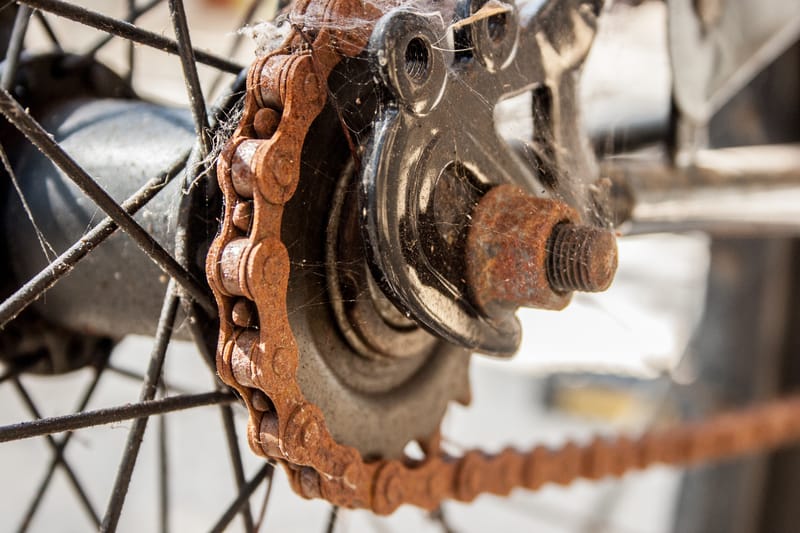
If you’ve ever owned a bike, which gives you a lot of great exercise, you also know how they have a tendency to rust. Most commonly perhaps, the rusty bike chain. Getting rid of the rust is not too hard.
The same way you did with the concrete, you will need to clean the chain before, which can be done with a dry cloth to remove all the dirt it has accumulated. At this point, you can either apply the lemon juice, lime or white vinegar to the chain, or you can simply take it off and dip it in these liquids, or leave it there. When the rust has loosened from the metal, make sure to rinse it off, leaving all rust particles.
When you add the chain back to the bike, you should use lubricant too, which will make it run easier too. The chain should only be added back after it has dried completely. There are other parts of the bike that will also get rusty, and you can use aluminum foil to wipe those down and get the rust off.
Severely improving the look of your bike does not take as much work as you might imagine. All you’ll need to do is remove the rust. The sooner you have it removed, the easier it will also be to have done. Address rust early and save yourself a headache later on.
Painting Over
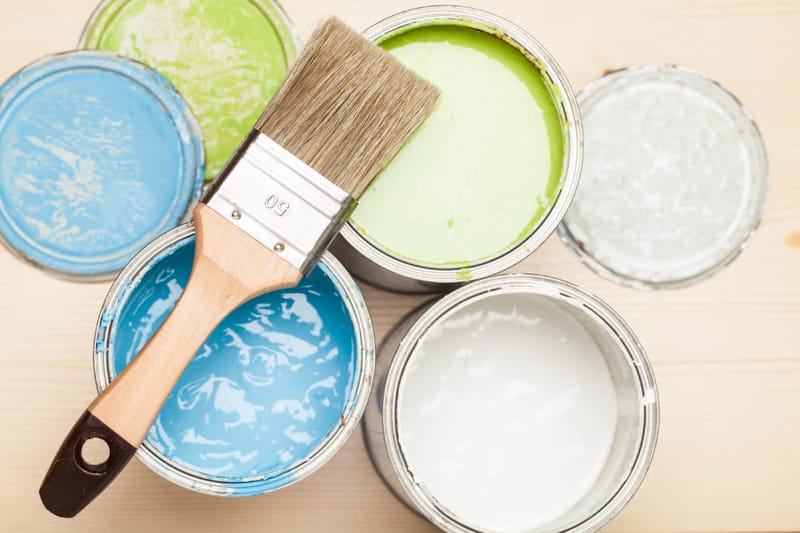
Using paint on an area that was previously covered in rust is possible, but there’s work to do first, which starts off by you removing the rust from the tools or the other objects you’d like to paint. Instead of throwing the tools away, take the time to get rid of the rust and repaint everything.
The preparation part is very important, so you’re in fact not painting over rust, you’re painting over where rust used to be.
The preparation, where you remove the rust is very important, which starts with you either using a solution like vinegar to remove the rust, or maybe you choose to sand them down instead. Again, the rust needs to be rinsed off, and then leave everything to dry. If there is parts of the tools that you don’t want paint on, you can tape off those areas.
When that’s been done, you will always want to ensure that the place you’re using to paint is well-ventilated, and that there isn’t any risk of other things unintentionally getting paint on them, by making sure the areas sealed off.
Before applying the actual coat of paint to the metal, you will want to use the appropriate primer to ensure good adhesion to the metal. The directions are probably written on the can, if you’re using canned primer. Make sure the different layers of primer have sufficient time to dry and use the paint that you want to.
Leave the tools to dry before you start using them again, so the paint can fully stick to the surface.
How to Remove Stains from Carpets

Picture form One Little Project
Once in a while you may experience rust on your carpet, which can leave some nasty stains, but how do you go about removing these stains? There are different causes for these stains, including furniture with metal footings, and other things that cause the carpet to have contact with metal. It can also be caused by leaky appliances. As we already mentioned, there is a bit of iron in water, and this could cause stains. Luckily, there are things you can do to get those rust stains out of the carpet.
Before you start, you will want to make sure the carpet is completely dry, and you can then grab a tool to scrape off as much excess rust as you can. For example, this could be a very dull knife or another tool that’s good for scraping. The more excess material you’re able to get from using this method, the better your chances of removing the stains completely.
When you do try and scrape off excess matter this way, you will need to know there’s a risk of pulling the carpet threads, which in itself could cause problems. The process is therefore extremely delicate, and try to avoid loose threads from the pulling and scraping.
To avoid damaging the carpet, anything that comes in contact with it needs to be cold, and not hot. The solution you either mix or buy should be tested out on a patch of carpet where you won’t mind too much if it bleaches. This is simply to see how your carpet reacts to the solution. A good place to try it out is underneath your couch, by first moving it, or maybe behind other furniture where a little bleached spot won’t be noticed. Remember, not all carpets are made equal, meaning they won’t react the same way to a liquid solution.
When you see that it hasn’t bleached or damaged the carpet, try applying it to the spot with the rust. Make sure you don’t add too much, and use a sponge to apply it. When you start seeing the stain being lifted, you will need to rinse the sponge also. You may even need to change the water several times.
Lemon juice and salt mixed together becomes a good abrasive cleaner with potential for lifting an annoying rust stain.
Vinegar can also be used here, but the trick is still to first watch the effect it has on a part of the carpet that you don’t mind too much if it gets bleached.
We hope this extensive article taught you a little bit about how you can use vinegar, lime, lemon and other products to get rid of those annoying rust stains, and make your carpet, bike and tools look like new ones again.